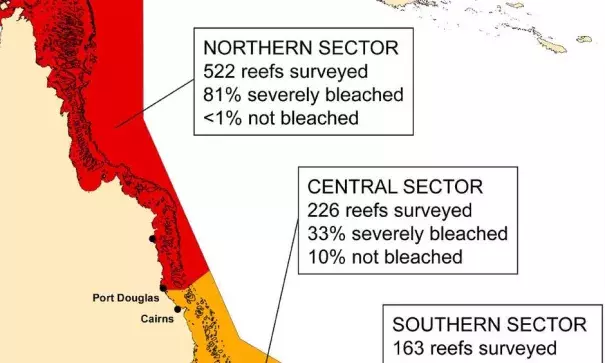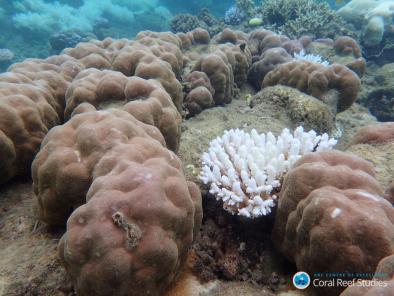Only 7% of the Great Barrier Reef has avoided coral bleaching

“We’ve never seen anything like this scale of bleaching before. In the northern Great Barrier Reef, it’s like 10 cyclones have come ashore all at once,” says Professor Terry Hughes, convenor of the National Coral Bleaching Taskforce that is documenting and studying the event. “Towards the southern end, most of the reefs have minor to moderate bleaching and should soon recover.”
“We have now flown over 911 individual reefs in a helicopter and light plane, to map out the extent and severity of bleaching along the full 2300km length of the Great Barrier Reef. Of all the reefs we surveyed, only 7% (68 reefs) have escaped bleaching entirely. At the other end of the spectrum, between 60 and 100% of corals are severely bleached on 316 reefs, nearly all in the northern half of the Reef.”
Underwater, teams of scientific divers have confirmed the accuracy of the aerial surveys, and are continuing to measure the ongoing impact of the bleaching.
“The bleaching is extreme in the 1000km region north of Port Douglas all the way up to the northern Torres Strait between Australia and Papua New Guinea,” says Prof. Andrew Baird from the ARC Centre of Excellence for Coral Reef Studies, who has spent the past 17 days at sea.
“Tragically, this is the most remote part of the Reef, and its remoteness has protected it from most human pressures: but not climate change. North of Port Douglas, we’re already measuring an average of close to 50% mortality of bleached corals. At some reefs, the final death toll is likely to exceed 90%. When bleaching is this severe it affects almost all coral species, including old, slow-growing corals that once lost will take decades or longer to return.”
More modest bleaching is now reaching its peak in a 600km central band of the Great Barrier Reef, between Cairns and Mackay. According to the scientists, reefs further south have escaped damaging levels of bleaching because water temperatures there were closer to the normal summer conditions over recent months.
“The severity of bleaching in the central section is less, and closer to the intensity of the first two mass bleaching events on the Barrier Reef, in 1998 and 2002,” says Prof. Hughes. “Thankfully, many of the corals there are more moderately bleached, so we expect that most of them will survive and regain their normal colour as temperatures drop over the coming months.”
Related Content



